Port Moresby Recompression Chamber… If you have ever been on a dive trip to Papua New Guinea you will noticed the line item at the bottom of your bill. It says something like “Environmental & Safety Fees” and you probably wondered what they actually were, but just paid it anyway and assumed (should that be hoped?) the money was being well-spent.
While in transit overnight in Port Moresby recently I had a chance encounter with John Miller of ProDive PNG. Which led me down an interesting path to a part of the capital’s Jackson Airport I only vaguely knew existed. For about 500m south of the main terminal building is Tropicair. One of the main charter operators in PNG, and its subsidiary Medicair – the main provider of emergency medical evacuations in the country.
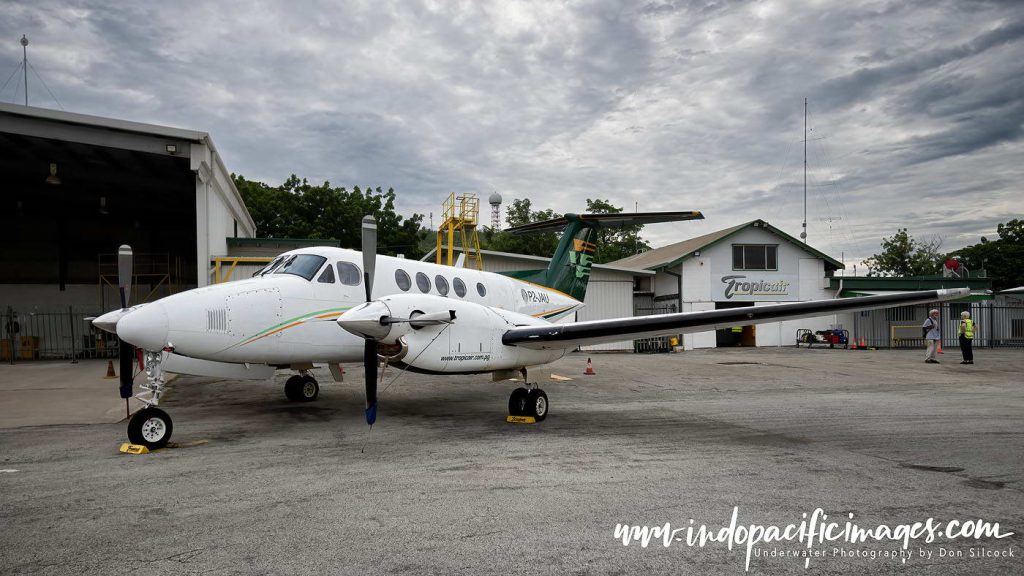
Almost hidden away at the back of that terminal. Behind an inconspicuous white door, is the main benefactor of those fees – PNG’s only recompression chamber.
Port Moresby Recompression Chamber – Duty of Care
Papua New Guinea is an incredibly wild and interesting place. Often referred to as one of the last frontiers, the country offers experiences at a level that are simply not possible any longer in many other parts of the world.
The topography above and below the water is exceptional. And the pioneers of diving in PNG faced some incredible challenges in establishing their operations. You could fill a book with their stories, and I may well do so one of these days… But one very significant hurdle they all faced was how to deal with a case of decompression sickness in a remote location?
All the operators carry supplies of oxygen as the first and critical step. While that obviously helps it simply cannot resolve the problem – only recompression treatment can do that. And there are two basic things required to make that happen. First there has to a be an accessible and fully functional chamber, together with support staff available somewhere in country. Secondly the effected diver has to be transported safely to that location.
Such shared needs were one of the main reasons why the PNG Dive Association (PNGDA) was formed back in the mid 1990’s. And one of their first major initiatives was acquiring and setting up a recompression facility in Port Moresby. The location of which has changed four times over the years – shall we say because of “local dynamics”. Then in January 2019 it was relocated to the Tropicair facility.
Let’s hope it stays put as it seems perfectly positioned to do what it does!
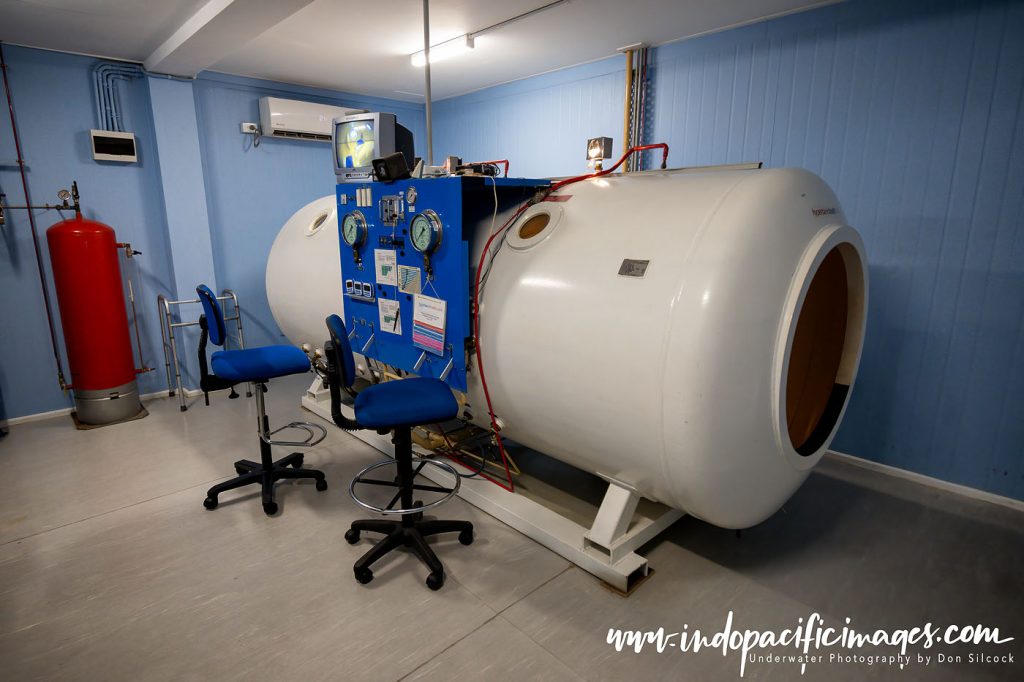
Your Worst-Case Scenario…
It was mid-afternoon, and the light was perfect as you pursued that oh-so special photo opportunity. Before you knew it had happened you were way deeper than briefed to go and seriously into deco.
Because you had gone so deep you burned through your gas supply. So, no choice but to abandon your mandatory deco stop and get to the surface before the remaining gas was gone. Hoping that nobody notices the beeping sound from your computer you finally get back to the boat. Get your gear off and disappear into your cabin to try and recover your composure.
But as the minutes tick by it becomes increasingly obvious that the laws of physics are indeed laws. Not options that can be ignored, and the pain in your joint is not going to go away. At which point you have no choice but to fess up to the skipper what has happened. And this is when all the background stuff steps to the fore…
Standard Operating Procedures
The PNGDA has developed Standard Operating Procedures (SoP”s) for all its members. So that when you are explaining your predicament the person that has suddenly been tasked with your welfare has a process and checklist to follow.
Once oxygen is being administered the next major step is a remote consultation with Dr Bobby Wellsh – PNG’s hyperbaric medical specialist and DAN’s man on the ground.
Dr Wellsh is a busy guy and does not sit behind a desk in Port Moresby waiting for a call… Rather he travels extensively in-country and how to contact him (or his designated alternate) in an emergency is integral to that SoP.
His assessment is pivotal to what happens next. Because if his judgement is that evacuation and treatment in Port Moresby is required one of the first questions you will be asked is who is your insurance with?
DAN Insurance
As I write this my mind wanders back over the many times I have renewed my DAN insurance over the years.
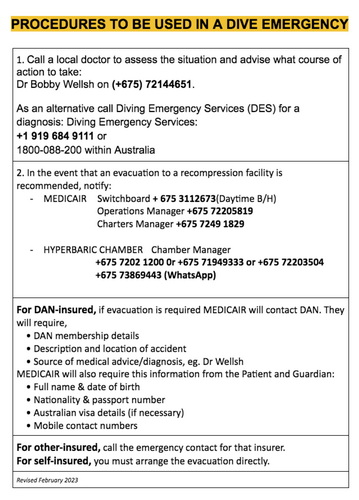
Back in the day (young, overconfident and indestructible…) I used to wonder whether I really needed to pay for it. These days I pay for it willingly and after peeling the onion on the Port Moresby facility I reckon it’s an absolute bargain! The basic thing is that medical evacuations are incredibly expensive. Because a specially outfitted plane, capable of conducting the evacuation with sea level cabin pressure while flying at altitude, is usually required. Together with a specifically trained crew.
Tropicair is set up to do exactly that – but will only press go if they are sure they will be paid.
If you are insured with DAN all Tropicair need is Dr Welsh to authorize the evacuation. As all contractual arrangements have already been negotiated and agreed. But if you are not then your insurance company’s emergency assistance have to be contacted and Tropicair formally authorized to proceed.
If you are self-insured, you will have to arrange the evacuation with Tropicair directly!
Port Moresby Recompression Chamber – PNG Logistics
Let’s look on the bright side… The oxygen has helped reduce the pain, you are stable and have excellent chances of recovery. IF you can get timely and effective ttreatment in a recompression chamber as quickly as possible.
You also have DAN insurance and Tropicair are good to go. But the afternoon has slipped by while all the drama has unfolded, and the sun is low in the sky. While Port Moresby Airport is capable of round-the-clock operation. Very few regional airports and none of the landing strips have landing lights. So, the evacuation must be timed from first light the next day at the nearest landing point. With the departure of the Tropicair flight from Moresby arranged to suit.
You will have had to grin and bear it overnight, but at least the cavalry is on the way. On the other hand, it’s hard to imagine having to struggle through the night with no end in immediate sight. Together with the pressing need to somehow get Tropicair authorized to proceed and get you out before sunset the next day!
See what I mean about DAN’s insurance looking like a bargain?
The Port Moresby Chamber
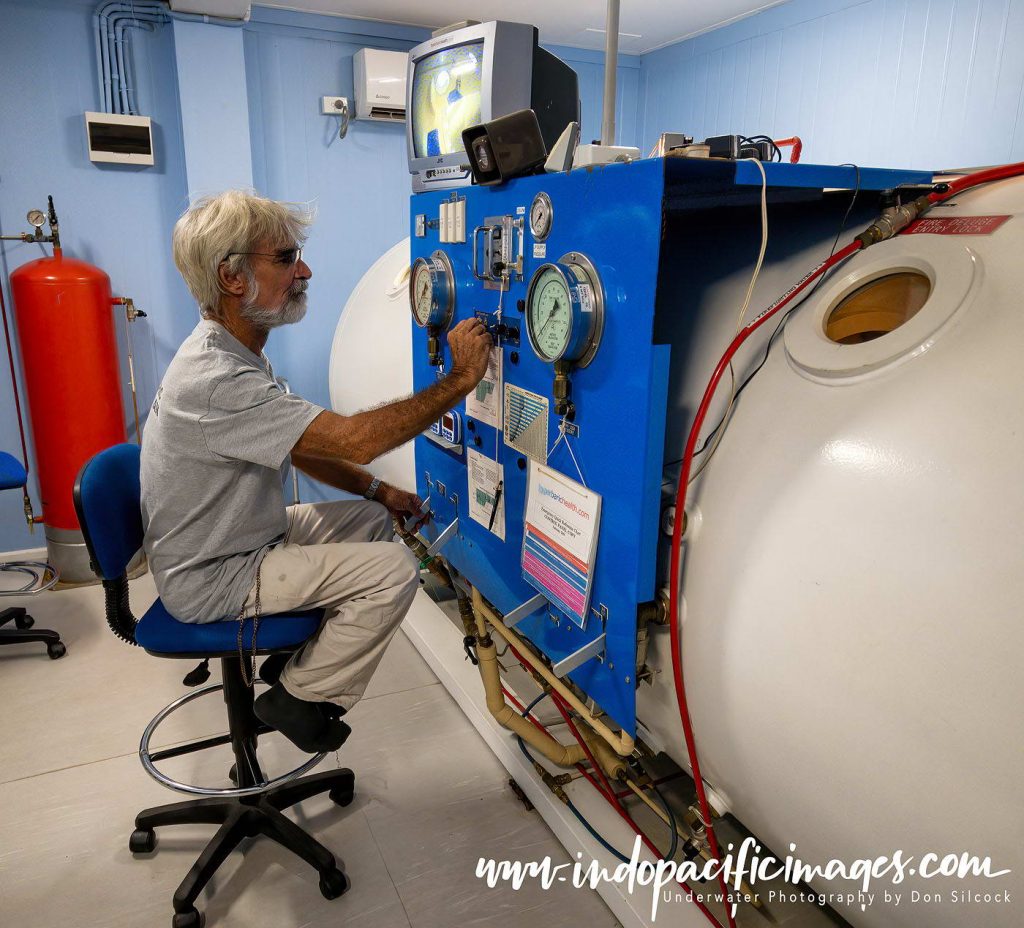
The recompression chamber in Port Moresby is one of only a few in the overall region. With the closest alternative facility in Townsville. Another at Honiara in the Solomon Islands and a third up in Guam.
It is a very important and strategic facility for both DAN and the PNGDA. With all the hardware and equipment owned, maintained and managed by DAN via its affiliate Hyperbaric Partners.
Capable of accommodating one patient comfortably, two at a push – plus a qualified hyperbaric treatment nurse. The chamber has two compartments so that the patient can remain under pressure in the main section. While access in to and out of the chamber is possible through the second compartment.
Redundant systems for power and high-pressure stored air are in place. Plus the chamber has onboard fire suppression, audio and visual communication systems.
John Miller is the facility coordinator and together with qualified local hyperbaric technicians organizes all maintenance and staffing requirements. He also conducts the actual treatment program prescribed and supervised by Dr Wellsh.
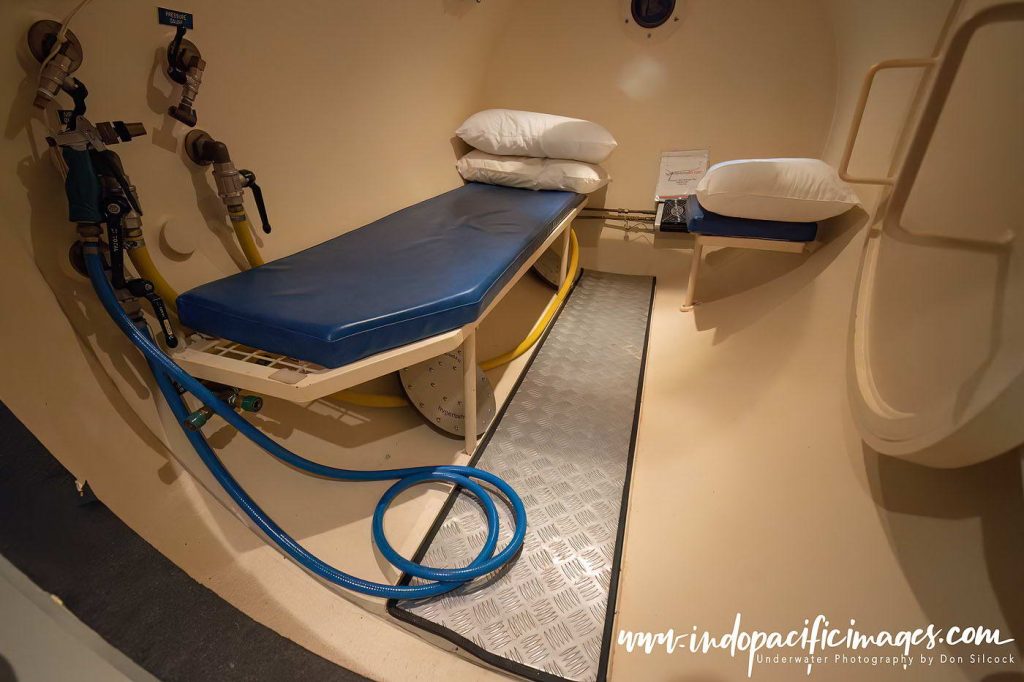
DAN’s Duty of Care
My visit to the Port Moresby recompression chamber really opened my eyes to the challenges associated with operating such a facility. John Miller was sincere and convincing as he explained how it all worked. And, as he did, I realised just how little most divers visiting PNG would know about the facility and decided to write about my experience.
But… I wanted to fact-check what I had heard and John put me in touch with DAN’s VP Safety Services Francois Burman – who promptly answered my questions in an honest and open manner.
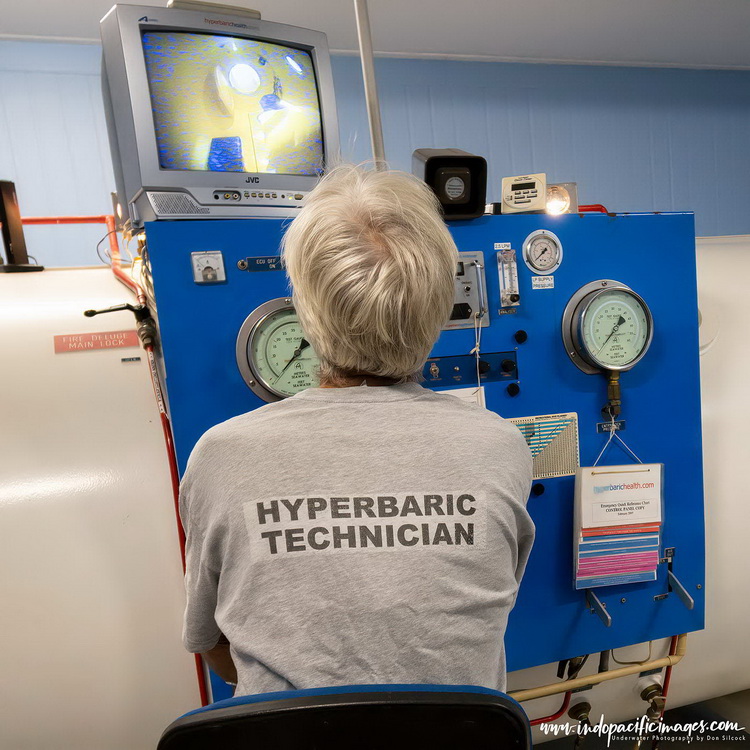
Explaining the logistical and operational challenges involved in providing medical support and evacuation to DAN members in isolated locations.
It all starts with that initial remote consultation. And understanding if they are dealing with a diving related illness like DCS or a non-diving one such as a heart condition.
There is very little point in evacuating a seriously bent diver to a local facility that cannot treat them. Or somebody with a heart condition to a recompression chamber!
It turns out that the Port Moresby chamber is somewhat of a poster child for DAN. Because not only is it funded locally through those Environmental & Safety Fees.
But it is also well staffed, maintained and operated with fully trained and qualified local personnel.
Plus, it is right there in the terminal of PNG’s most qualified and equipped medical evacuation provider.
Port Moresby Recompression Chamber – In Summary…
I must be honest and state that while I have been to Papua New Guinea many times over the years and, was aware there was a recompression facility in-country, I had no real idea of how it all functioned.
What I learned from that chance encounter with John Miller and all that came after left a deep and very positive impression. At the end of that trip, when my bill arrived, I paid those fees willingly. Knowing it money very well spent!
